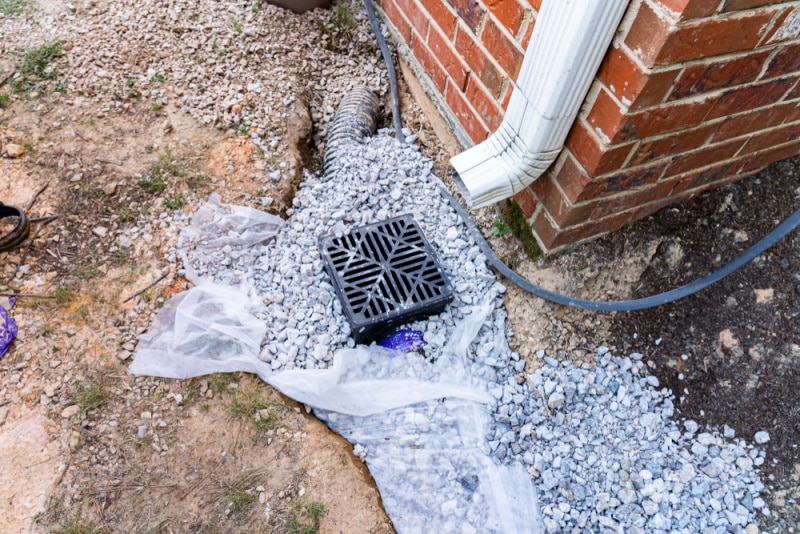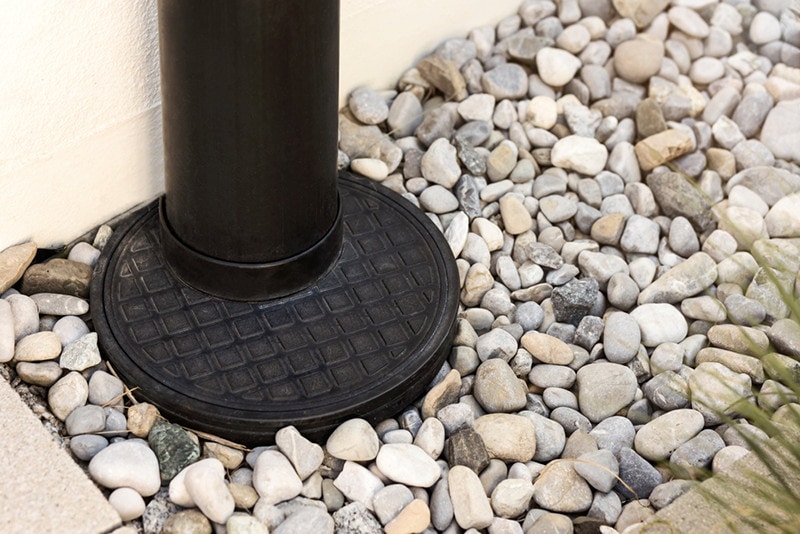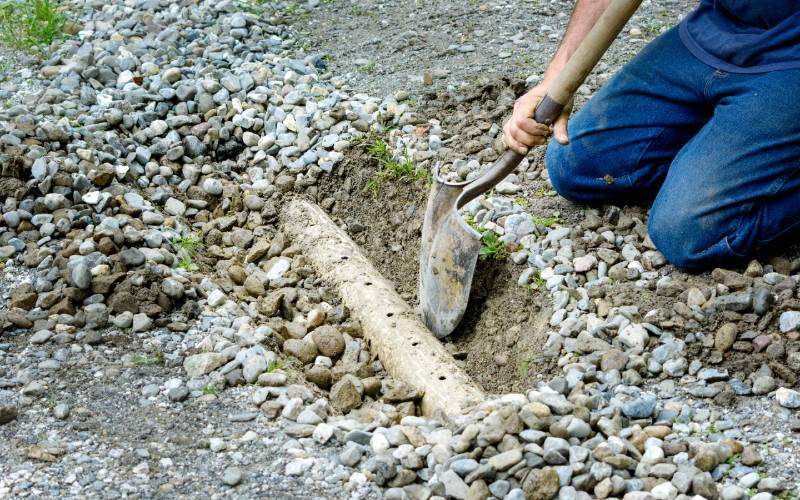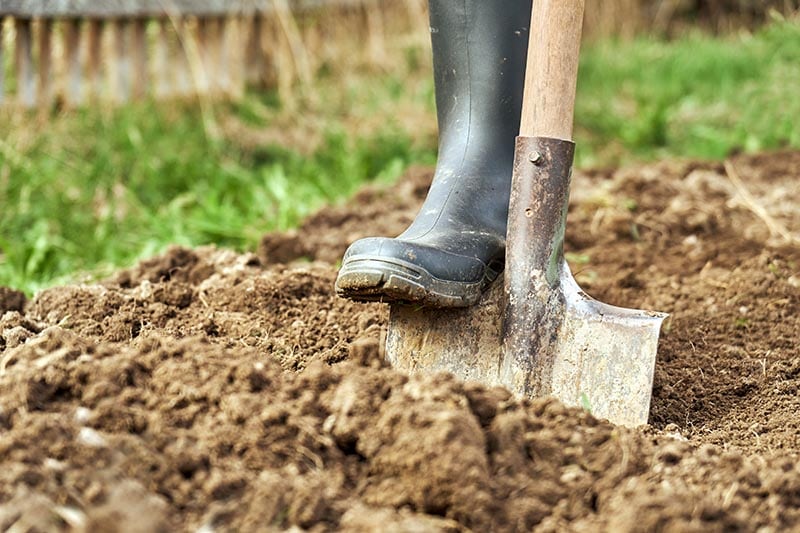How Does a French Drain Work? What You Need To Know
-
Ed Malaker
- Last updated:

If heavy rains are creating standing water on your property, a French drain can help you get rid of the water permanently so your grass and plants can grow. If you are unsure what a French drain is or how it works, keep reading as we provide a detailed explanation and go over its advantages and disadvantages.
How Does It Work?
A French drain is a ditch that’s dug at a slight inclination. Inside the ditch at the bottom is one or more pipes with small holes or perforations along the entire length of the pipe. Builders fill the trench and cover the pipe with rock and gravel. When it rains, water flows into the ditch, and as the water rises, it flows into the small perforations in the pipe and drains away quickly to another location, such as a storm drain, dry well, pond, or lake.

What Are the Different Types of French Drains?
- Curtain Drain – A curtain drain is the most common type of French drain and helps direct water away from roadways and eliminate standing water. People call it a curtain drain because it usually isn’t too deep below the surface. The pipes can vary in size from just a few inches in diameter to several feet, especially in areas that need to move a large amount of water.
- Footing Drain – A footing drain is a French drain that protects a home’s foundation. These drains go around the entire perimeter of the house and can be several feet below the surface at the footing of the foundation, which is where they get their name. A footing drain will usually direct water to a cistern, where a sump pump can pump the water to a more suitable drain.
- Interior Drain – As the name suggests, an interior drain is a French drain that is installed inside the house, usually to remove water leaking into the basement. While shallow like the curtain drain, it can be difficult and expensive to install because it usually requires digging a trench in the basement floor.
Where Is It Used?
Henry Flag French, a farmer in Massachusetts, first described how to use this type of drain in the mid-1800s and made the first examples using ordinary roofing tiles with a small gap between them. He invented the system to help drain swampy areas so crops could grow better, and people have been using it for a wide range of draining applications ever since. French drains help keep water off roadways and highways and away from the foundation of the house. You can install them in your yard to take care of standing water or improve drainage in your garden. They are also essential for keeping sand traps dry at the golf course and are part of how a standard septic system works.

Advantages of French Drains
The primary advantage of a French drain is that it can carry water away from any location while remaining underground. You can use them anywhere without worrying about a ditch running through your yard. French drains are also fairly inexpensive and easy to install compared to other options because you can build them from plastic pipe, rocks, and gravel.
Disadvantages of French Drains
- Expensive – The disadvantage to French drains is that they can be expensive to install if the ground is hard to dig into or if you are placing them around the perimeter of your home, where they need to be several feet down. Interior drains can also be expensive to install because breaking up cement requires special tools. You may need to dig a dry well or create a cistern too, so the water has somewhere to drain.
- Ineffective With Soil – Unfortunately, French drains aren’t suitable for all kinds of soil. For instance, clay is compact and water doesn’t flow through it easily. So, if you have a large amount of clay or compact dirt on your property, there is a good chance that a French drain won’t be that effective.
- Clogging – French drains are susceptible to clogging because gravel can wash in and clog the holes, and plant roots can do the same, causing the drain to become less effective. Many people place a special cloth around the drain pipe to prevent clogging, but this cloth can make it more difficult for water to enter the pipe and drain away. In any case, your French drain will likely need frequent maintenance to keep it working properly.
- Improper Installation – Another problem with French drains is that if you don’t install them properly, water can pool in unexpected locations as it drains out of the pipe through the perforations instead of into a storm drain, lake, or another suitable area. Random water pooling usually happens when the inclination isn’t steady and one part of the pipe dips down because of improper installation or ground settling. You will need to reinstall the French drain if the water is creating a problem.

 Frequently Asked Questions (FAQs)
Frequently Asked Questions (FAQs)
Can I Install a French Drain Myself?
Yes. A curtain-style French drain is fairly easy to install yourself, and it can be a great way to remove standing water from your property or help your garden drain better. However, if you are installing a French drain to protect your home’s foundation or are dealing with a large amount of water, it might be best to hire a professional.

What Are French Drain Pipes Made Of?
Most French drain pipes are either a flexible black corrugated plastic or a rigid white PVC pipe with several holes drilled in the side. Both are fantastic options that can last many years.
How Deep Should the French Drain Be?
The depth of your French drain can vary considerably, depending on its type and the amount of water that it needs to move. Most curtain-style French drains are usually 18–24 inches deep at their deepest point, where it empties into a storm drain or another suitable location.
 Conclusion
Conclusion
A French drain entails water entering a perforated pipe under the ground and draining quickly to a suitable location. To install this type of drain, contractors will dig a ditch at a slight inclination and place the perforated pipe inside before covering it with rock and gravel, which helps hide the drain and provides a usable surface while still enabling water to reach the pipe. If you have a small amount of standing water on your property or desire better drainage in your garden, you can try to install the drain yourself. However, we recommend hiring a contractor for bigger jobs, like for a footer drain; when dealing with a large amount of water from a pond or swamp; or when you need to create a place for the water to drain, like a dry well or cistern. When you install it properly, a French drain can quickly move water away from your property, even during heavy rains.
Featured Image Credit: Stephen Reeves, Shutterstock
Contents
